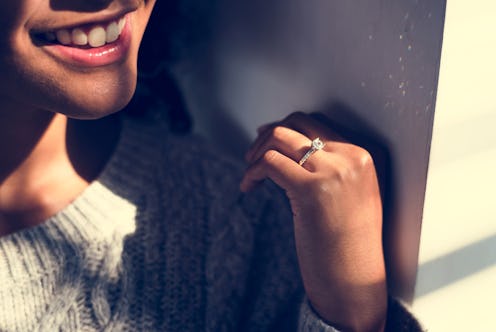
If you're thinking about getting married, chances are you'd like a diamond engagement ring to be part of the equation. Whether you give it to your spouse-to-be, or they get down on bended knee and present one to you, there's no denying it's a tradition so deeply engrained in our society, it's almost weird not to dream about a sparkling addition to your lives as a couple.
Picking out a unique ring can also be a fun part of the engagement process. You might go for something classic and simple, or big and gleaming. Or you might have your grandmother's vintage ring resized, in order to carry on a family tradition. Whatever you choose, the ring can be a beautiful thing, in many ways.
And yet, perhaps less romantically, the truth is we tend to associate diamonds with engagement thanks to a very clever advertising scheme. "Before the 1940s, only about 10 percent of engagement rings had diamonds in them," Aran Galligan, an eco-friendly jewelry designer and founder of Aide-mémoire Jewelry, tells Bustle. "The diamond cartel De Beers set out to change that with help from a marketing agency."
The classic slogan, "A Diamond is Forever," was created for the company in 1948 with the goal of shifting popular opinion on diamonds and convincing everyone that they were a necessary part of a marriage proposal, Galligan says. And it worked.
In fact, "the De Beers campaign, along with significant diamond product placement in Hollywood films and on the red carpet, was one of the most successful ad campaigns in history," Stephen Silver, a jeweler, gemologist, and geologist based in Silicon Valley, tells Bustle. "The campaign struck a nerve, successfully and subtly linking a diamond’s durability [with enduring love.]"
Diamonds have also come to represent enduring love thanks to their actual strength as a stone, which is another factor folks appreciate. "There's this thing that both jewelers and geologists use called the Mohs Hardness Scale, which rates stones on their hardness or durability," Kelsey Dickinson, from the custom jewelry design studio Abby Sparks Jewelry, tells Bustle. "A diamond is the hardest stone by a long shot."
Since engagement rings are typically worn on a daily basis, and potentially for decades at a time, this makes them a practical choice, too. "You bang it on your car keys, workout equipment [...] your desk, it gets caught in your sweater, gets stuck in car doors — you name it, we've seen it," Dickinson says. "So you want to make sure your engagement ring was made with really durable materials."
Of course, the diamond's durability — as well as its impressive shininess — is something people have admired for centuries, well before car doors or advertising companies existed. "The very first diamond engagement ring was given to Mary of Burgundy in the 15th century [...] by the Archduke Maximillian of Austria," Darshan Gajiwala, diamond expert and co-founder of Sun Diamond, tells Bustle. "This led to the practice of exchanging diamond engagement rings, but it was still a concept exclusively for the noble."
The market today may have made diamonds more accessible. But with an average cost of $4,758, they still aren't going to work for everyone. And there are other reasons, too, why a couple might shy away, including economic uncertainty, concerns about diamond sourcing, and questioning traditions, Galligan says.
Whatever the case may be, the good news is there are plenty of other options, should you and your partner still want to exchange a gleaming token of love. "Sapphires in all their colors (from pale peaches to teals and deep blues) have become much more popular in recent years," Galligan says. "People wanting a white stone for their ring are often choosing moissanite or a lab-grown diamond — both being a less expensive option than a natural diamond."
The history of diamond engagement rings spans decades, and even centuries. But when it comes to how you and your partner want to celebrate your engagement, the choice is up to you. A diamond may be forever, but it's definitely not the only option.